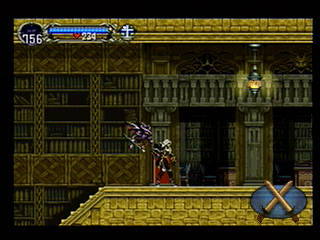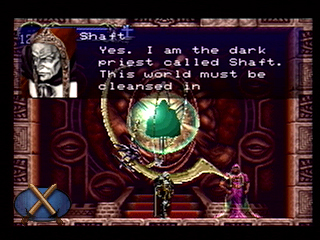|
|

|
PLATFORM
|
PSX
|
BATTLE SYSTEM
|

|
INTERACTION
|

|
ORIGINALITY
|

|
STORY
|

|
MUSIC & SOUND
|

|
VISUALS
|

|
CHALLENGE
|
Easy/Medium
|
COMPLETION TIME
|
3-15 Hours
|
|
OVERALL

|
Click here for scoring definitions
|
|
|
Konami's Castlevania: Symphony of the Night, released on both the Sega Saturn and Sony Playstation, is the direct sequel to the Japan-only game Dracula X: Rondo of Blood. Although Castlevania II: Simon's Quest first introduced RPG elements to the series, Symphony of the Night went further with them and established a franchise formula that would spawn many more Castlevania platform RPGs, chiefly for the Gameboy Advance and Nintendo DS. Even today, Symphony of the Night stands out as one of the strongest installments of the series and one of the best platform games created.
Throughout Dracula's castle, Alucard must battle many enemies, and can equip a variety of weapons, armor, and accessories. He can also jump, dash backwards, and gain a variety of moves and transformations that not only further his exploration of the castle, but also help in combat as well. As he kills enemies, he gains experience and can level up to increase stats, although there are special items that instantly increase maximum HP and hearts. He occasionally gains hearts by breaking candles and killing enemies, and can also find various tools such as knives, axes, and so forth that consume hearts when used, although he can only hold one of these tools at a time.
Combat flows smoothly for the most part, although there are some annoyances, such as the difficulty of executing magic spells the player can purchase from the library shop (which require a certain combination of buttons, although they really aren't the difference between victory and defeat in most instances), the need to equip consumable items to use them, that taking damage from enemies forces Alucard backward (which can at points force him down long vertical corridors), and the slight possibility of losing a lot of progress if Alucard dies and the player hasn't discovered a save point nearby. Still, combat integrates decently with castle exploration.
 Books--check 'em out
Books--check 'em out
|
|
Castle exploration is the highlight of interaction in Symphony of the Night, with new abilities and some items being necessary to advance the game. Maintenance of Alucard is also minimal for the most part, aside from the need to equip items to use them. Aside from that and the inconsistent spacing of save points at times, the interface is far more than passable.
Although Castlevania II did feature some RPG elements, Symphony of the Night went even further with these elements with things such as items to increase maximum HP and heart levels, and a giant castle to explore, while still featuring traditional series gameplay elements such as side-scrolling two-dimensional combat and heart abilities, all of which in turn makes the game a fresh experience that would influence most future portable installments.
Story, however, is probably the weakest aspect of the game, as it has been in just about every other installment of the franchise. There are some references to Rondo of Blood and Castlevania III, some minor development, and a few surprises, although story scenes tend to be scarce and short throughout the game. Of course, Castlevanias have never been about story, and the other aspects of the game are more polished, so this shortcoming is largely forgivable.
 A bad mother...watch your mouth
A bad mother...watch your mouth
|
|
The soundtrack features a nice diversity of tracks ranging from classical to samba that fit the game's various milieus, all of which are a pleasure to hear. Sound effects are decently executed as well, and the occasional voice acting is alright, though there are some weak lines. Still, Symphony of the Night, as its title implies, is easy on the ears.
The game is easy on the eyes, as well, with a decent two-dimensional visual style that has some rare three-dimensional elements present in a few enemies. The two-dimensional elements, though, are nicely executed, with Alucard perhaps being one of the most fluidly animated character sprites in the history of games, with the area and monster art being above average as well. There are some minor shortcomings such as the odd tendency of most enemies to explode upon defeat and that Richter Belmont's character sprite in no way resembles his dialogue portrait, but otherwise, the visuals leave little room for improvement.
Finally, playing time can range anywhere from as little as three to as long as fifteen hours depending upon how much of the castle the player wishes to explore, with some premature endings and a few different additional endings. There are also extra modes where the player can play as Richter Belmont and, in the Saturn version, Maria Renard. Overall, Symphony of the Night, even today, remains as one of the best Castlevania RPGs, with most of its aspects aside from its story being solid. Xbox 360 owners can download the game to experience it for themselves, and Playstation Portable owners can check it out as part of the anthology Castlevania: The Dracula X Chronicles.
Review Archives
|









